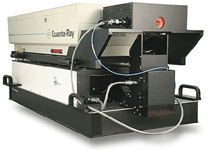 4D Technology Corp. recently received NASA’s Goddard Achievement in Excellence Award for its contribution to the James Webb Space Telescope project. The company partnered with NASA to develop an electronic speckle pattern interferometer (ESPI), which enables precision metrology on large flight hardware for the large, infrared-optimized space telescope scheduled for launch no earlier than June 2013. JWST is set to find the first galaxies that formed in the early Universe, connecting the Big Bang to the Milky Way galaxy.
4D Technology Corp. recently received NASA’s Goddard Achievement in Excellence Award for its contribution to the James Webb Space Telescope project. The company partnered with NASA to develop an electronic speckle pattern interferometer (ESPI), which enables precision metrology on large flight hardware for the large, infrared-optimized space telescope scheduled for launch no earlier than June 2013. JWST is set to find the first galaxies that formed in the early Universe, connecting the Big Bang to the Milky Way galaxy. The test requirements presented significant challenges, because existing technology was unavailable prior to 4D’s development of the SpeckleCam, a speckle interferometer insensitive to vibration. Test conditions involved acquiring measurement data rapidly in a high-vibration environment on nonreflective and diffuse surface structures. Additionally, meter-class structures needed to be measured from a distance of tens of meters in a cryogenic chamber. To accomplish this, 4D combined its pixilated phase-sensor technology with a high-energy pulsed laser. The high acquisition speed of the device makes it insensitive to vibration and air turbulence.
…
Add new comment